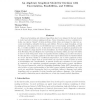Free Online Productivity Tools
i2Speak
i2Symbol
i2OCR
iTex2Img
iWeb2Print
iWeb2Shot
i2Type
iPdf2Split
iPdf2Merge
i2Bopomofo
i2Arabic
i2Style
i2Image
i2PDF
iLatex2Rtf
Sci2ools
JAIR
2007
2007
An Algebraic Graphical Model for Decision with Uncertainties, Feasibilities, and Utilities
Numerous formalisms and dedicated algorithms have been designed in the last decades to model and solve decision making problems. Some formalisms, such as constraint networks, can express “simple” decision problems, while others are designed to take into account uncertainties, unfeasible decisions, and utilities. Even in a single formalism, several variants are often proposed to model different types of uncertainty (probability, possibility...) or utility (additive or not). In this article, we introduce an algebraic graphical model that encompasses a large number of such formalisms: (1) we first adapt previous structures from Friedman, Chu and Halpern for representing uncertainty, utility, and expected utility in order to deal with generic forms of sequential decision making; (2) on these structures, we then introduce composite graphical models that express information via variables linked by “local” functions, thanks to conditional independence; (3) on these graphical models...
| Added | 15 Dec 2010 |
| Updated | 15 Dec 2010 |
| Type | Journal |
| Year | 2007 |
| Where | JAIR |
| Authors | Cédric Pralet, Gérard Verfaillie, Thomas Schiex |
Comments (0)

